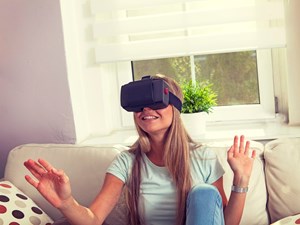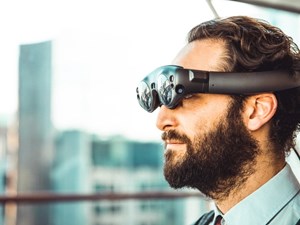Self-guided tours, drones and immersive reality can help real estate businesses moving forward during unprecedented challenges.

(Left to right) Pieter Aarts, Dan Burton, Rami Kalla. Images courtesy of roOomy, DroneBase and Point in Time Studios, respectively
Shaken by the coronavirus crisis, the whole world has taken drastic measures to minimize the spread of the virus. Avoiding crowds, switching to the work-from-home environment and social distancingare all common practice nowadays. This has had a significant impact on many industries, including real estate. For agents, brokers and property managers, it is essential to find ways to keep their businesses alive during these troubled times, and technology is stepping in to help them continue their activity.
The COVID-19 pandemic has been very difficult for industries where person-to-person contact is essential and, unfortunately, real estate falls into that category. “Many realtors and property managers have already leveraged drone technology to market new listings or inspect buildings to maintain infrastructure. Now more than ever, this technology is especially useful to ‘virtualize,’ as drones can enable brokers to gather the necessary aerial images, videos and data while adhering to social distancing guidelines,” Dan Burton, founder & CEO of DroneBase, told Multi-Housing News.
Burton is convinced that technology can help people adapt to a new reality, while still abiding by social distancing guidelines. He has professional pilots throughout the U.S, Canada, the U.K. and Europe, and safety has become his top priority. “In this particular situation, we are being especially mindful by mandating contact-free inspections and implementing additional safety protocols such as equipment sanitization to ensure pilot and customer safety,“ Burton stressed.
Protection is on everyone’s minds. Ben Margolit, CEO & co-founder of resident insight platform Rentgrata, thinks that currently it is not safe for the onsite staff of a multifamily property to be on premises. Therefore, a digital or virtual connection with a current or potential renter is necessary.
“If renters cannot tour the property, leasing teams need to offer platforms that will get renters more comfortable with their decision. Renters still want to learn as much as possible about an apartment community before signing a lease. Whether it’s virtual tours, FaceTiming with the leasing team or talking to current residents to get a pulse on the community, options need to be made available,” Margolit said.
Self-guided tours are one of the alternatives potential renters currently have. These can be completed without the assistance of the leasing team and are in accordance with social distancing protocols, so only one tour is allowed at a time. “The smart tech that is part of self-guided tours also means that the individual taking the tour will use their smartphone to open the lock of the model, making it a contactless experience,” Tour24 Co-Developer & Vice President John Doyle told MHN.
MORE BENEFITS

Image courtesy of Frank Vessia via Unsplash
Complying with social distancing guidelines is not the only reason real estate players are increasingly using technology in their everyday interactions with clients. In a time when saving capital and cutting costs are essential, efficiency becomes very important. Apart from drones, augmented and virtual reality have also reshaped the real estate industry. These technologies allow anyone to tour a property from anywhere in the world without physically interacting with agents or brokers, and they’re also a great way to bypass travel expenses.
“We recently produced a VR experience for a property in Spain and premiered it at a home show in London. It was such a huge success that the owners were able to sell 30 units in one weekend and generated over $10 million in sales, without their customers ever setting foot on the property,” Rami Kalla, founder of Point in Time Studios, said. Although the event Kalla referenced took place before the worldwide lockdown, the model is successfully being replicated in today’s environment as well.
Augmented reality and virtual reality have been revolutionizing the way users experience spaces. The difference between the two is that in AR the user experiences the real world, which has been digitally enhanced with the addition of virtual objects, while in VR the user is removed from the real world and taken to a completely simulated one, in which anything can be customized.
“By offering multiple design styles, we’re able to really personalize the space to the home-mover’s likings. That also differentiates virtual staging from physical staging, which is very expensive and static,” Pieter Aarts, CEO & co-founder of roOomy—a company that provides virtual staging services, interior design apps and 3D modeling for the real estate industry—told MHN.
ADAPTING TO THE NEW NORMAL
These technologies are not only viable during a worldwide health crisis, but also in the long run. “Self-guided tours are not ‘pandemic exclusive,’ but rather something the new generation of renters was already demanding of the industry. The pandemic may just speed up broader adoption,” Doyle added.

Image courtesy of Yanick via Unsplash
Property owners or managers who want to corner the Millennial market usually focus on technological amenities. But real estate agents and brokers can also rely on technology to attract Millennials and Generation Z, some of the greatest fans of technology and online experiences. “Personally, I don’t even think there are people who start their search for a new home without browsing online first. Through technology, they’re actually saving time because people who are looking for a home have already made a preselection,” Aarts explained.
And as these technologies continue to rapidly evolve, the younger generations’ appetite for using digital reality in every interaction they have will only increase. “As Millennials age and Generation Z enters the housing market, they have a desire and willingness to try new technology. They will expect that they can tour your property with a virtual leasing agent hologram from the comfort of their home, sign a lease or purchase without ever stepping foot on your property,” Kalla said.
Additionally, virtual tours and the use of VR enable brokers and agents to connect with customers on a more personal level, without even meeting face to face. It’s no secret that emotion influences a buyer’s or a renter’s behavior and these technologies enhance that emotional connection that customers form when they visit—even virtually—a potential new home. “With VR, I can not only put you in the story, but I can enhance other senses, such as audio and touch,” Kalla explained.
BRACING FOR LONG-TERM CHANGE
According to research by the National Association of Realtors, staged homes close faster and for higher prices than non-staged homes. No wonder important industry players reacted even before the pandemic took over almost every aspect of the real estate business. “These technologies have already revolutionized the industry. Big companies like Sotheby’s International Realty or Toll Brothers are buying in on new technologies like augmented and virtual reality,” Aarts said.
Kalla expects VR to irreversibly change the industry and become part of our everyday lives, similar to smartphones, making it hard to remember a time without it. “I expect that in the next five to 10 years, AR/VR wearables will become very commonplace. We will make calls, surf the web and tour properties with our AR/VR wearables that will be no bigger than our glasses now. If you want me to go further into the future, they will get smaller, down to contact-lens size and then implants,” Kalla expects.
Technology will never replace human touch, but it will continue to offer convenience, Margolit points out. Also, the trying times we are living today will become a key reference for selecting the best tech solutions to work with going forward.
“The multifamily industry, as well as many others, will feel the effects of this pandemic for a long time. Buying decisions on the part of our clients and other large enterprises will be made with this scenario in the back of their minds. Can this particular technology, this business, weather the next storm? It’s something that will be considered long after the fog has lifted,” he concluded.
View full PDF here
[SOURCE: MULTIHOUSING NEWS – link]
